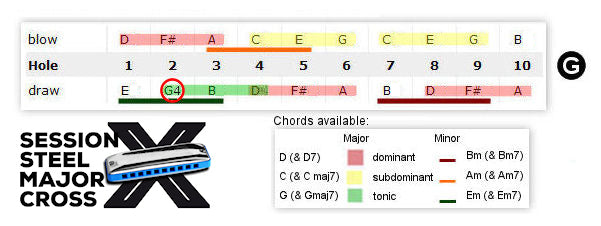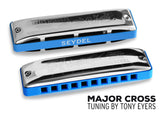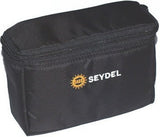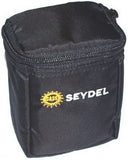Seydel Session Steel Special Tuning Major Cross Tuning 10315 includes Free USA Shipping
Tony Eyers' MAJOR CROSS tuning - corrosion-free Blues harmonica with stainless steel reeds, ergonomically shaped covers and plastic comb.
The MAJOR CROSS tuning, developed by Tony Eyers, allows a major scale to be played in second (or cross) position without any bending. While many players use second position, they often find traditional tunes challenging, due to the bending/overblowing needed for some notes.
MAJOR CROSS eliminates this problem. Moreover, as bending/overblowing is generally not needed, Major Cross harmonicas are well suited to the fast speeds common with traditional fiddle tunes.
Three other positions are available for Major Cross harmonicas. These are:
- 4 hole draw as the root note: this is for “modal” tunes, e.g. Red Haired Boy, an American bluegrass standard
- 3 hole blow as the root note: this is for minor tunes, such as “Drowsy Maggie”, a well known Irish tune
- 1 hole draw as the root note: another minor position, for tunes like “Jerusalem Ridge”, another bluegrass standard
Listen to the 'Tony Eyers Trio' to see what can be done on MAJOR CROSS tuned instruments - namely a D and a Low D in the video!
The difference between MAJOR CROSS tuning and the usual Richter tunings is shown below. The “root” note for second or cross position is the two hole draw and this note is used for labeling the instruments as well.
Three other positions are available for Major Cross harmonicas. These are:
- 4 hole draw as the root note: this is for “modal” tunes, e.g. Red Haired Boy, an American bluegrass standard
- 3 hole blow as the root note: this is for minor tunes, such as “Drowsy Maggie”, a well known Irish tune
- 1 hole draw as the root note: another minor position, for tunes like “Jerusalem Ridge”, another bluegrass standard
Besides very intuitive melody playing the MAJOR CROSS tuning opens new options for playing chordal accompaniment as well!
In the table below you can see that the most important chords (major and minor)) are available in a very easy to remember arrangement:

Chords available on a Major Cross (key of G)
The MAJOR CROSS tuning is labeled in Cross-Position (here G), so the note in 2 draw is the root note and the tone table below shows the MAJOR CROSS in G - however the basis for a MAJOR CROSS in G is a usual Richter tuned diatonic in the key of C:

A:B comparison between Major Cross (root note G) and Richter tuning (root note C)











